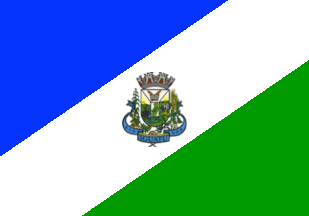 image by Ivan Sache, 3 February 2022
image by Ivan Sache, 3 February 2022
Last modified: 2022-03-05 by ian macdonald
Keywords: parana | iguatu |
Links: FOTW homepage |
search |
disclaimer and copyright |
write us |
mirrors
 image by Ivan Sache, 3 February 2022
image by Ivan Sache, 3 February 2022
The municipality of Iguatu (2,258 inhabitants in 2018; 10,694 ha) is located
500 km west of Curitiba.
Iguatu was established in 1958, as Gleba No. 09,
subsequently renamed to Jaburandi, and, eventually to Iguatu, for a Tupi-Guarani
word meaning "Good Water". This refers to the abundance of freshwater, but also
to Rio Bom ("Good River"), a municipality located in North Paraná from which
several colonists originated.
http://www.iguatu.pr.gov.br/
Municipal website
The flag and arms
of Iguatu are prescribed by Municipal Law No. 31 promulgated on 12 November
1993.
Article 6.
The flag of the municipality of Iguatu, designed by
heraldist and vexillologist Reynaldo Valascki, shall be diagonally divided per
bend.
This is compliant with the norms of vexillology, according to which
municipal flags shall be divided in eight, six, four or three, with the same
colors as those of the field of the coat of arms.
§1. The flag of the
municipality of Iguatu is composed of two isosceles triangles, blue (azure) in
the upper part and green (vert) in the lower part, and of a white (argent)
stripe charged in the center with the municipal coat of arms.
§2. The flag of
the municipality of Iguatu obeys the general rule, being divided in three parts
per bend. The coat of arms applied in the flag's center represents the municipal
government, the white stripe represents peace, tranquility and religious spirit
of Iguatu's people. The blue triangle symbolizes the firmament, beauty,
nobleness, justice, perseverance, loyalty and also the beautiful veil of Our
Lady. The green triangle symbolizes wealth, hope, cultivated areas, plains and
forests existing over the whole municipal territory.
Article 8.
The
coat of arms of the municipality of Iguatu, designed by heraldist and
vexillologist Reynaldo Valascki, is described in proper words as follows.
§1.
A Portuguese classic shield surmounted by a four-towered mural crown argent
windows gules. The shield's field divided in five distinct quarters; the upper
quarter featuring a book and two quills representing education and culture in
the municipality of Iguatu.
§2. In the second, left quarter a sun fertilizing
the municipal territory, above beautiful plantations and a tractor with a farmer
growing rich, fertile lands, representing the municipality's agricultural
resources.
§3. In the third, right (dexter) quarter, a horse, an oxen and a
pig representing the municipality's resources in animal breeding.
§4. In
base, a beautiful topographical landscape representing Iguatu's municipal lands;
in the center, rivers Piquiri, Novais and Sapucai, as well as brooks and sources
at the origin of name of Iguatu, a Tupi-Guarani word meaning "Good Water", and
beautiful plains, representing the resources existing on the whole municipal
territory, also a tribute to the pioneers and clearers of the municipality's
rich and fertile lands.
§5. In the center, a drawing of the map of the
municipality of Iguatu.
§6. The shield supported right (dexter) by coffee,
bean and wheat plants and left by tobacco, soybean and maize plants, all proper,
representing the main crops offered by the generous and fertile soil.
§7.
Above the scroll a cogwheel representing the municipality's industry.
§8. The
blue scroll is inscribed in the center in letters argent with the toponym "Iguatu"
and dates "10-11-1991" and "01-01-1993", the date of political and
administrative emancipation of the municipality of Iguatu.
The coat of
arms has the following symbolic interpretation.
a) The Portuguese classic
shield used to represent the arms of Iguatu is of German origin and was
introduced in Iberia during the struggle against the Moors; it was used in
Portuguese arms, namely in domains' heraldry, evoking the colonizing race and
main builder of the Brazilian nationality.
b) The mural crown that surmounts
it is the universal symbol of domains' arms; argent (silver) with six towers,
only four of them visible in perspective view, it classifies a 3rd rank town, or
municipal seat. The windows gules (red), through the heraldic meaning of this
color, recall the proper attributes of the pioneers and leaders of the
community.
c) Blue (azure) is a symbol of nobleness, justice, perseverance,
zeal, loyalty, recreation and beauty.
d) Argent (silver) is a symbol of
peace, friendship, work, prosperity, purity and religious spirit.
e) Or
(gold) is a symbol of glory, splendor, greatness and sovereignty; sable (black)
symbolizes prudence, moderation, authority and firmness.
f) The outer
ornaments, coffee, bean, wheat, tobacco, soybean and palm fructed plants are
symbols of the municipal income.
https://leismunicipais.com.br/a/pr/i/iguatu/lei-ordinaria/1993/4/31/lei-ordinaria-n-31-1993-dispoe-sobre-a-forma-e-apresentacao-dos-simbolos-do-municipio-de-iguatu-e-da-outras-providencias
Leis Municipais database
Photo
https://www.facebook.com/prefeituraiguatu/photos/2961624347426738
Ivan Sache, 3 February 2022